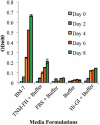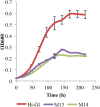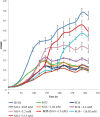Development of Chemically Defined Media Reveals Citrate as Preferred Carbon Source for Liberibacter Growth
- PMID: 29675013
- PMCID: PMC5895721
- DOI: 10.3389/fmicb.2018.00668
Development of Chemically Defined Media Reveals Citrate as Preferred Carbon Source for Liberibacter Growth
Abstract
Liberibacter crescens is the closest cultured relative of four important uncultured crop pathogens. Candidatus L. asiaticus, L. americanus, and L. africanus are causal agents of citrus greening disease, otherwise known as huanglongling (HLB). Candidatus L. solanacearum is responsible for potato Zebra chip disease. Cultures of L. crescens grow slowly on BM-7 complex medium, while attempts to culture the Ca. Liberibacter pathogens in BM-7 have failed. Developing a defined medium for the growth of L. crescens will be useful in the study of Liberibacter metabolism and will improve the prospects for culturing the Ca. Liberibacter pathogens. Here, M15 medium is presented and described as the first chemically defined medium for the growth of L. crescens cultures that approaches the growth rates obtained with BM-7. The development of M15 was a four step process including: (1) the identification of Hi-Graces Insect medium (Hi-GI) as an essential, yet undefined component in BM-7, for the growth of L. crescens, (2) metabolomic reconstruction of Hi-GI to create a defined medium for the growth of L. crescens cultures, and (3) the discovery of citrate as the preferred carbon and energy source for L. crescens growth. The composition of M15 medium includes inorganic salts as in the Hi-GI formula, amino acids derived from the metabolomic analyses of Hi-GI, and a 10-fold increase in vitamins compared to the Hi-GI formula, with exception choline chloride, which was increased 5000-fold in M15. Since genome comparisons of L. crescens and the Ca. Liberibacter pathogens show that they are very similar metabolically. Thus, these results imply citrate and other TCA cycle intermediates are main energy sources for these pathogens in their insect and plant hosts. Thus, strategies to reduce citrate levels in the habitats of these pathogens may be effective in reducing Ca. Liberibacter pathogen populations thereby reducing symptoms in the plant host.
Keywords: biochemical composition; chemically defined medium; culturing; metabolism.
Figures





Similar articles
-
Growth parameters of Liberibacter crescens suggest ammonium and phosphate as essential molecules in the Liberibacter-plant host interface.BMC Microbiol. 2019 Oct 12;19(1):222. doi: 10.1186/s12866-019-1599-z. BMC Microbiol. 2019. PMID: 31606047 Free PMC article.
-
Growth Dynamics and Survival of Liberibacter crescens BT-1, an Important Model Organism for the Citrus Huanglongbing Pathogen "Candidatus Liberibacter asiaticus".Appl Environ Microbiol. 2019 Oct 16;85(21):e01656-19. doi: 10.1128/AEM.01656-19. Print 2019 Nov 1. Appl Environ Microbiol. 2019. PMID: 31420343 Free PMC article.
-
Identification of the Genes Required for the Culture of Liberibacter crescens, the Closest Cultured Relative of the Liberibacter Plant Pathogens.Front Microbiol. 2016 Apr 20;7:547. doi: 10.3389/fmicb.2016.00547. eCollection 2016. Front Microbiol. 2016. PMID: 27148230 Free PMC article.
-
Progress and Obstacles in Culturing 'Candidatus Liberibacter asiaticus', the Bacterium Associated with Huanglongbing.Phytopathology. 2019 Jul;109(7):1092-1101. doi: 10.1094/PHYTO-02-19-0051-RVW. Epub 2019 Jun 3. Phytopathology. 2019. PMID: 30998129 Review.
-
Huanglongbing Control: Perhaps the End of the Beginning.Microb Ecol. 2018 Jul;76(1):192-204. doi: 10.1007/s00248-017-1123-7. Epub 2017 Dec 1. Microb Ecol. 2018. PMID: 29196843 Review.
Cited by
-
Effects of Deficit Irrigation and Huanglongbing on Sweet Orange Trees.Front Plant Sci. 2021 Oct 15;12:731314. doi: 10.3389/fpls.2021.731314. eCollection 2021. Front Plant Sci. 2021. PMID: 34721459 Free PMC article.
-
Growth parameters of Liberibacter crescens suggest ammonium and phosphate as essential molecules in the Liberibacter-plant host interface.BMC Microbiol. 2019 Oct 12;19(1):222. doi: 10.1186/s12866-019-1599-z. BMC Microbiol. 2019. PMID: 31606047 Free PMC article.
-
A high-throughput system to identify inhibitors of Candidatus Liberibacter asiaticus transcription regulators.Proc Natl Acad Sci U S A. 2019 Sep 3;116(36):18009-18014. doi: 10.1073/pnas.1905149116. Epub 2019 Aug 19. Proc Natl Acad Sci U S A. 2019. PMID: 31427509 Free PMC article.
-
Growth Dynamics and Survival of Liberibacter crescens BT-1, an Important Model Organism for the Citrus Huanglongbing Pathogen "Candidatus Liberibacter asiaticus".Appl Environ Microbiol. 2019 Oct 16;85(21):e01656-19. doi: 10.1128/AEM.01656-19. Print 2019 Nov 1. Appl Environ Microbiol. 2019. PMID: 31420343 Free PMC article.
-
Comparative Proteomic Analysis of Sweet Orange Petiole Provides Insights Into the Development of Huanglongbing Symptoms.Front Plant Sci. 2021 Apr 19;12:656997. doi: 10.3389/fpls.2021.656997. eCollection 2021. Front Plant Sci. 2021. PMID: 33953735 Free PMC article.
References
-
- Cooper W. R., Sengoda V. G., Munyaneza J. E. (2014). Localization of ‘Candidatus Liberibacter solanacearum’ (Rhizobiales: Rhizobiaceae) in Bactericera cockerelli (Hemiptera: Triozidae). Ann. Entomol. Soc. Am. 107 204–210. 10.1603/AN13087 - DOI
LinkOut - more resources
Full Text Sources
Other Literature Sources

